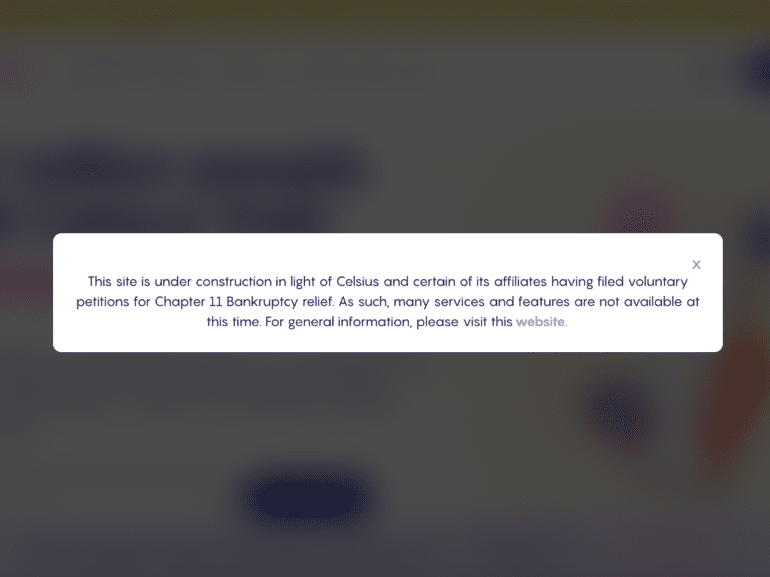It feels like not so long ago since CEO Alex Mashinsky spoke at the Fintech Nexus 2022 New York event. Terra had recently tumbled, and there was a buzz among attendees discussing the catastrophe.
Mashinsky spoke of “blood in the streets” and the power of decentralization to fix some of the financial sector’s issues that result in crashes.
RELATED: Celsius CEO cited crypto ‘blood on the streets’ weeks before company shutdown
Three weeks later, due to “extreme market conditions,” Celsius announced a halting of all withdrawals, swaps, and transfers between accounts.
The Three Arrows Capital (3AC) and Celsius debacle shook the DeFi community. The world watched as seemingly invincible giants in the ecosystem crashed and burned — each one filing for bankruptcy and facing endless lawsuits that rage on.
The carnage is unfolding in real-time. Within the mess, Voyager and Tornado Cash also met their demise, along with many others, and experts are still unsure of the ending.
So, where did it all go wrong?
Four years ago, Fintech Nexus contributor, Tony Zerucha, interviewed Mashinsky. The CEO spoke of this company: as “the complete opposite of banks, with transparency at its core.”
Founded in 2017, Celsius rose to have $25 billion under management by October 2021, offering trading and loan services with promises of high yields. Although that amount had dropped to $11.8 billion in May, it still seemed like plain sailing on the surface.
However, the recent bankruptcy filing, submitted in July, unearthed a $1.2 billion hole in the company’s balance sheet and around $4.6 billion still owed to customers.
Subsequent investigations in the light of the bankruptcy filing have slowly revealed elements that bring the self-proclaimed “transparency” to question.
Regulators have gone so far as to describe the company’s operations as resembling a Ponzi scheme, stating in their filing, “Celsius also admitted at the 341 meetings that the company had never earned enough revenue to support the yields being paid to investors. This shows a high level of financial mismanagement and suggests that at least at some point in time, yields to existing investors were probably being paid with the assets of new investors.”
The company admitted, through the statement of its CFO, Chris Farrero, that monetary issues had started as far back as 2020 with “massive losses in the first seven months of 2021” despite continued assurances and statements from Mashinsky that all was well.
In the declaration of Ethan McLaughlin, Assistant General Counsel at the Vermont Department of Financial Regulation, Celsius showed losses of over $450 million in the space of 10 days in early May 2022.
Earlier Freeze reports from 2021 showed losses of $690 million.
According to posts made to investors before the bankruptcy filing, Celsius’ demise was purely a result of the Spring 2022 extreme crypto market volatility.
The chaos unfurls
Let’s go back to the fateful succession of events.
March 29, 2022 – Celsius announces a “limited time promotion” on new LUNA deposits, requiring a 90-day lockup.
May 8, 2022 – Rumbling fears of a Terra depeg surface, with publications reporting a 10% decrease of LUNA and major withdrawals from Anchor Protocol. Anchor deposits fell from $14 billion to $11.2 billion during this time.
At this time, Terra’s algorithmic stablecoin was described as a “major backbone” of the crypto community.
May 11-12, 2022 – In 48 hours, the stablecoin crashes 99% in a “major correction,” with LUNA tumbling from $80 per token to under $1.
May 11, 2022 – Mashinsky denies Celsius involvement in a LUNA bailout.
May 18, 2022 – Celsius customers report that they were “unfairly wiped out” in the recent crash, and Mashinsky accuses “unknown malefactors” of sabotaging the company.
May 19, 2022 – Mashinsky assures Twitter followers that Celsius’ exposure to the LUNA crash was minimal, asking them to trust the official posts of the company.
May 25, 2022 – Celsius fails to post its weekly report of asset holdings. Mashinsky speaks for the last time at a public forum at Fintech Nexus USA in New York.

June 13, 2022 – Celsius announces a pause on withdrawals and transfers due to “extreme market conditions.” New loans are still available to customers through the “Borrow Program.”
Values of other major cryptocurrencies, namely bitcoin, and ethereum, start to slip significantly after the announcement.
June 17, 2022 – The Wall Street Journal reports that Three Arrows Capital Ltd. (3AC) is seeking legal and financial advice following the LUNA crash, revealing the company had significant investments of around $200 million in the algorithmic stablecoin.
June 19, 2022 – “Unconfirmed rumors on Twitter” reported by BanklessDAO contributors of Celsius bailout by FTX in the light of the LUNA collapse.
June 22, 2022 – Voyager digital stocks drop by 60% after disclosing exposure to 3AC through a loan which at the time was valued at $720 million. Sam Bankman-Fried, CEO of FTX, extends a credit line, through Alameda, of $200 million in cash and USDC in addition to 1500 BTC, available in withdrawals totaling $75 million every 30 days.
Amid continued reports of the extent of 3AC liabilities, people turn to Twitter to speculate on “fraud.” Bankless DAO contributors describe the situation to have reached a “peak tomfoolery level.”
June 23, 2022 – Twitter reports that Voyager reduced the daily withdrawal limit from $25 thousand to $10 thousand.
June 24, 2022 – Celsius is reported to have taken on more advisors and consultants in preparation for bankruptcy filings.
June 27, 2022 – 3AC enters liquidation and defaults on the loan from Voyager. Voyager announces they have already used the total $75 million from Alameda.
June 30, 2022 – News reports said FTX walked out of bailout proceedings after seeing the company’s balance sheet.
July 6, 2022 – Voyager files for bankruptcy.
July 7, 2022 – Celsius served a lawsuit by former investment manager Jason Stone, who left the company in March 2021 and reported a balance sheet hole of hundreds of millions the company could not resolve. Stone accused the company of artificially inflating its coin price, failing to hedge risk, and engaging in activities that amounted to fraud.
July 13, 2022 – Celsius files for bankruptcy.
July 18, 2022 – Court filings show a loan from Celsius of $75 million to 3AC despite the company’s claims of zero exposure.
Aug. 14, 2022 – Kirkland and Ellis LLP, a law firm hired by Celsius to aid restructuring, filed a report showing liabilities at $6.6 billion, more than double the amount initially filed.
Aug. 19, 2022 – Ferraro discloses that Celsius used over $40 million in cash on crypto mining activities two weeks after filing for bankruptcy.
Sept. 1, 2022 – Kirkland and Ellis LLP filed a document stating that “approximately $70 million of proceeds from the repayment of USD denominated loans.” could help the company to continue operations until the end of 2022. The loans were originally and “mistakenly believed” to be in dollar-pegged stablecoins, which the lender could not use to fund operations.
In denial or genuinely hopeful, Celsius powers on
The domino effect of the proceedings is apparent, as is the chaos and confusion of the news and rumors surrounding the destruction. However, in the setting of a “DeFi” world that claimed to hold transparency at its core, allegations of fraud and dishonesty are rife.
Bankruptcy and lawsuit proceedings showed mounting evidence that Celsius’ problems started long before the 3AC craziness, proving a record of dishonesty from Celsius towards its stakeholders. The failure to hedge risk caused “massive liabilities while the company’s holdings paled.
While investors in Celsius continue to await news of repayment for their losses, Mashinsky announces plans for reviving the company.
He is reported to have addressed employees of the firm in early September. A meeting recording was anonymously sent to crypto blogger Tiffany Fong. “How many of you drink Pepsi vs. Coca-Cola?” he said.
“Well, Pepsi filed for bankruptcy twice, right? Does it make Pepsi taste less good? Delta filed for bankruptcy, right? Do you not fly Delta because they filed for bankruptcy? So the point is, a bankruptcy filing is a test for the company — it’s a test of: should you come out or should you disappear?”
Seemingly blind to the blast area surrounding the Celsius et al. explosion, he tells of the support of their community, communicating a belief that the bankruptcy is a minor blip, from which the company will bounce back.
“We will need to be able to successfully convince customers that Celsius is a place where they can park their assets and have trust. They will have to trust us as a company,” he said.
He has also announced a three-step plan to rekindle the company’s success.
With dwindling trust in the centralized “DeFi” actors and Celsius’ dismal track record of deceit unearthed by legal proceedings, an independent examiner has been appointed to oversee the continuing bankruptcy proceedings.


